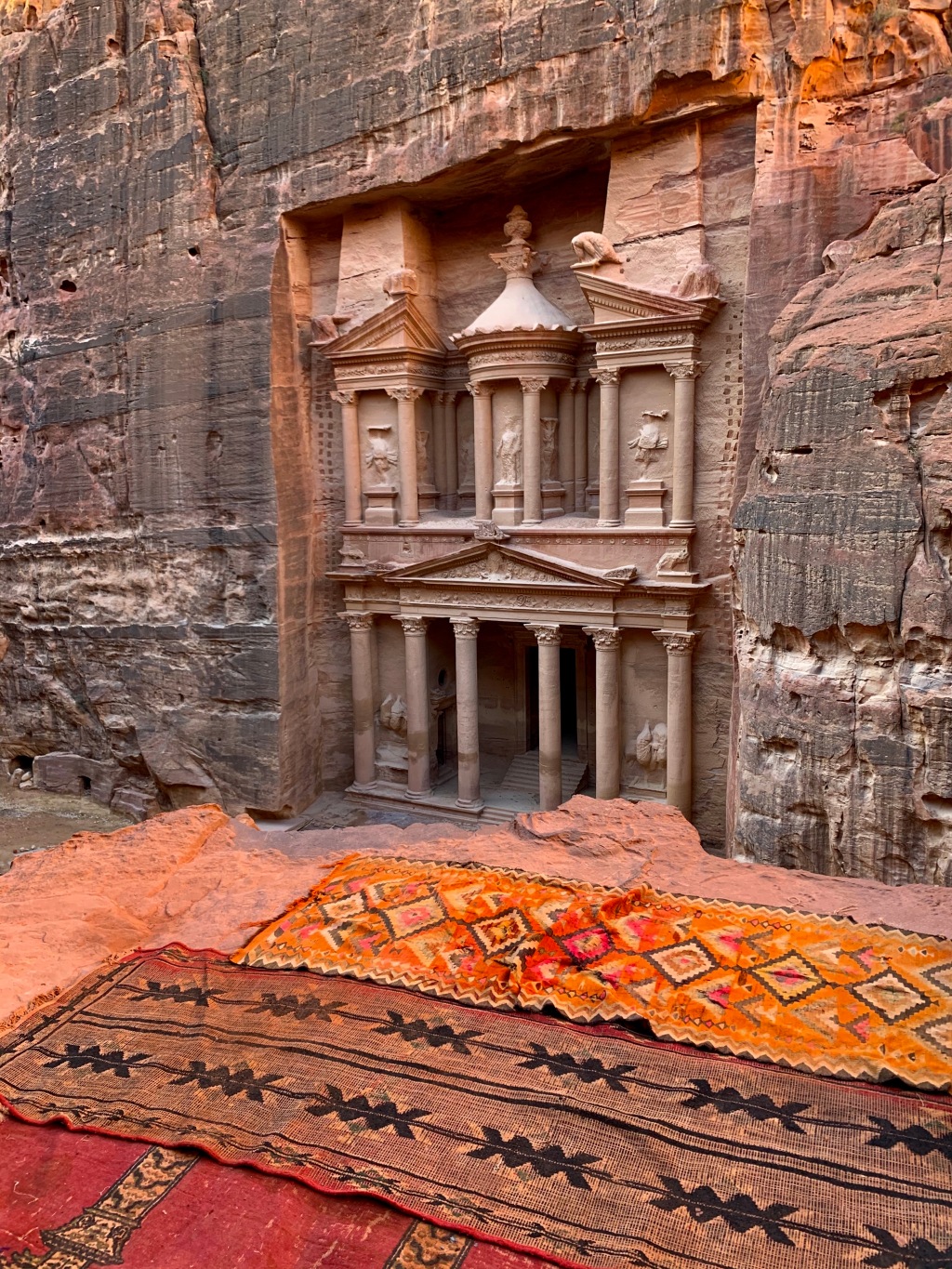THINGS TO KNOW BEFORE YOU GO TO JORDAN
Make sure to buy the Jordan Pass that includes your visa and visit to Petra.
WHAT IS THE JORDAN PASS?
The Jordan Pass is the ultimate sightseeing package that has been especially tailor-made for visitors to the beautiful Kingdom of Jordan. For only JD70 ($98USD) the Jordan Pass gives pass holders the ability to make the most out of their trip. The Jordan Pass also includes a waived visa fee of JD40 ($56USD) for most nationalities If you buy it in advance and plan to stay a minimum of three nights.
With the Jordan Pass, you can visit top sights and attractions while saving time, money and effort.
-
Hassle-free prepaid entry to over 40 attractions in Jordan, such as: Petra, Jerash, Wadi Rum, Amman Citadel, Ajloun Castle, Umm Qays, Qasr Al-Azraq, Quseir Amra, Karak Castle, Pella, AlHallabat, Umm Ar-Rasas, Umm Qays Museum, Umm al-Jimmal, Shobak Castle, Al-Hamimah, Museum of Popular Traditions, Jordan Archaeological Museum, Aqaba Museum, Madaba Archaeological Museum, As-Salt Museum, Karak Museum, As-Saly Historical Museum, Church of the Apostles, and many more.
- Free downloadable digital brochures covering all of Jordan’s tourist attractions.
HOW DOES IT WORK?
Amman, Jordan
I took this photo of the city from my room at the St. Regis, Amman.
Trust me when I say 24-hours is all you need to check out Amman. You could walk around the entire city within 3 hours. Take a look at some of the things to do and see.
Rainbow Street
The Rainbow Street, originally named Abu Bakr al Siddiq Street, is a public space in the historic area of Jabal Amman, near the center of downtown Amman, Jordan. The street runs east from the First Circle to Mango Street and contains several attractions from rooftop restaurants and pubs, to shops, dining (both everyday cuisine and fine dining).
Best hotels in Amman
The St. Regis Amman
Other hotels in Amman: W Amman, Amman Marriott Hotel, Four Seasons Hotel Amman, InterContinental Amman, Crowne Plaza Hotel Amman, Fairmont Amman
Best Restaurants in Amman
All of the restaurants have a 4-dollar sign on TripAdvisor. That is because the standard price for most places is high compared to others locally. However, it’s relatively affordable compared to the rest of the world.
In this case, just to give you an idea of what the restaurant actually costs, I have initiated my own cost signs.
One odd fact about the majority of the restaurants in Amman: the high-end restaurants are mostly steakhouses. Apparently, people in Amman love steak.
Also, once again, I’d like to point out that in every city that I visit I usually try restaurants specializing in local cuisine, steaks, Italian, and Japanese.
The following four restaurants are located at the Fairmont Amman:
Nur Lebanese Dining (Lebanese, Middle Eastern) $$$
Salt (Steakhouse) $$$
Nasim (Middle Eastern) $$$
Tsuki (Japanese) $$$
The following three restaurants are located in the InterContinental Hotel:
Bourj Al Hamam (Lebanese, Mediterranean, Barbecue) $$$
Rodeo Grill (Steakhouse) $$$
La Capitale (French) $$$
The following restaurant is located at the Crowne Plaza Hotel Amman:
V Lounge & Restaurant (Steakhouse) $$$
The following restaurant is located in the Amman Marriott Hotel:
IL Terrazzo Amman Restaurant (Italian) $$$
The following five restaurants are located at The St. Regis Amman:
Mercado Andaluz (Spanish) $$
Mercado Andaluz boasts a contemporary atmosphere, a lively open kitchen and a delightful interpretation of Spain’s traditional local markets.
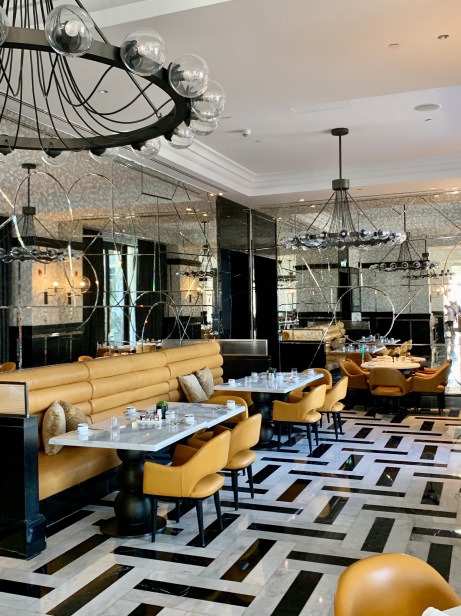
Tamara (Middle Eastern) $$$
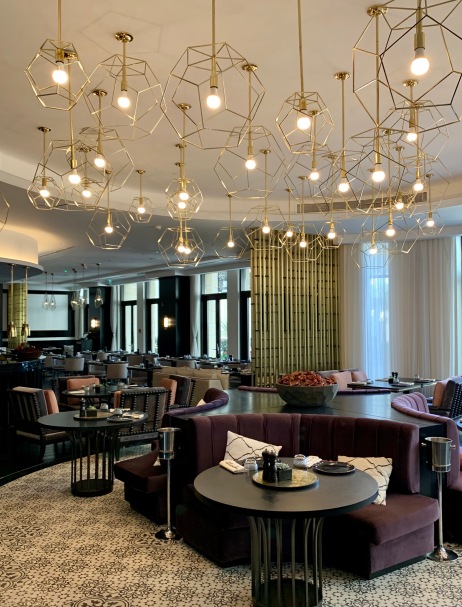
Named after the Goddess of rivers and water, Tamara provides a chic, stately ambiance with vibrant splashes of color, ancient artifacts, elegant lighting, and modern furnishings. The restaurant specializes in Jordan & Middle Eastern cuisine.
Zenith (Grill) $$$
Head to Zenith during your time in Amman for flavorful grilled meats and a welcoming restaurant atmosphere.
St. Regis Bar (International) $$
St. Regis Bar is one of Amman’s most celebrated gathering places for business and leisure.
Tea Lounge (International) $$
Drawing inspiration from a quintessential St. Regis tradition, the Tea Lounge serves an impeccable selection of fine teas and other refreshments in a casual setting.
Other best restaurants in Amman:
Sufra Restaurant (Middle Eastern) $$
La Maison Verte (French) $$$$
Gusto Italian Restaurant (Italian) $$$
Fakhreldin Restaurant (Lebanese, Middle Eastern) $$$
ThreeSixty (International) $$$
Levant Restaurant (Lebanese, Middle Eastern) $$$
From Amman: on to Madaba City
Madaba, Jordan
Madaba City is located between Amman and the Dead Sea. The drive to the Dead Sea takes three hours in the mountains from Amman. This drive is a must. It has stunning landscapes. Make sure to take a pit stop at Madaba City and check out:
St. George’s Church & Mosaic Map
The Madaba Map, also known as the Madaba Mosaic Map, is part of a floor mosaic in the early Byzantine church of Saint George in Madaba, Jordan. The Madaba Map is of the Middle East, and part of it contains the oldest surviving original cartographic depiction of the Holy Land and especially Jerusalem.
From Madaba City to the Dead Sea
It takes an hour from Madaba City to the Dead Sea. The 26km ride is a scenic mountain car ride.
As you ger closer to the Dead Sea, you will stumble across many pits stops where you can view Dead Sea vistas.
Dead Sea, Jordan
The Dead Sea is a salt lake bordered by Jordan to the east and Israel and the West Bank to the west. It lies in the Jordan Rift Valley, and its main tributary is the Jordan River. Its surface and shores are 430.5 meters below sea level, making it the Earth’s lowest elevation.
Best Hotels in Dead Sea, Jordan
Kempinski Hotel Ishtar Dead Sea
This was my first time ever to stay at a Kempinski Hotel. I must say that the stay was amazing. The hotel offers a free mud body mask and sea salt scrub. Local spas offer the same amenities for approximately $150USD, so be sure to take advantage of this free service.
Other hotels in Dead Sea:
Dead Sea Marriott Resort & Spa
Dead Sea Marriott Resort & Spa is set on the shores of the legendary Dead Sea. Marriott Resort & Spa is more than your average hotel in Jordan. The resort in Sweimah is a restorative experience in the heart of the world’s most celebrated natural wonders. The expansive on-site spa is an integral part of the resort. It offers a retreat for guests to unwind, and offers a full menu of treatments and a unique Dead Sea salt pool. In addition, Jordan Valley Marriott Resort & Spa is proud to be the first hotel in the Middle East to switch to solar panel energy for hot water.
Movenpick Resort & Spa Dead Sea
Hilton Dead Sea Resort & Spa
Crowne Plaza Jordan Dead Sea Resort & Spa
Best Restaurants in the Dead Sea
Most restaurants at the Dead Sea are located inside the resorts and hotels.
Dead Sea Marriott Resort & Spa
II Terrazzo Restaurant (Italian) $$
Movenpick Resort & Spa Dead Sea
Luigi’s (Italian) $$
Kempinski Hotel Ishtar Dead Sea
Ashur Pizza & Grill Restaurant (Italian, Mediterranean) $$
Crowne Plaza Jordan Dead Sea Resort & Spa
Burj Al Hamam (Lebanese) $$
Bacchus Restaurant (Italian) $$
From the Dead Sea to Petra
Driving to Petra from the Dead Sea takes about three hours. You will pass along a luscious landscape of mountains and desert vistas.
PETRA, JORDAN
Petra is a UNESCO World Heritage Site. It is the ancient capital city of the Nabataean people, and was recently proclaimed as one of the New Seven Wonders of the World.
Downtown Petra (Wadi Musa)
Wadi Musa is a town located in the Ma’an Governorate in southern Jordan. It is the administrative center of the Petra Department and the nearest town to the archaeological site of Petra. It hosts many hotels and restaurants for tourists, and there is an important Bedouin settlement approximately 2 kl (1 mi) from the town.
Petra’s Main Attraction
More than two thousand years old, Petra was built by the Nabataeans in the heart of the Shara Mountains. It prospered in the 1st century BC & AD and was a vital part of a major trading route connecting ancient Mesopotamia and Egypt. Today, intricate facades sculpted into the sandstone cliffs of the area can still be seen, along with other remarkably preserved structures and monuments of this fascinating civilization.
When visiting Petra, it will take you roughly two hours to travel by foot from the entrance to the Monastery at the end of the road.
Take a look at this map to give you an idea of how Petra is laid out.
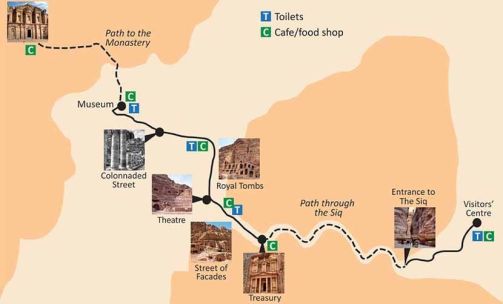
First things first: When you buy your entry ticket at the Visitor Center, make sure to have your passport and/or photo ID. This is because the attendant will check to make sure that the name on the ticket matches your ID.
You then will make your way past the entrance to the various attractions. You can walk through the site or you can choose to take a horse-drawn cart (this is included in your Jordan Pass)
Bab Al Siq
‘Bab Al Siq’ is Arabic for the gateway to the ‘Siq’. Here you will see three massive Djinn blocks, which are squared monuments. You will then come across the Obelisk Tomb, carved by the Nabataeans in the 1st century AD. Above the tomb are four pyramids (‘nafesh’) and a niche with a statue in bas-relief that symbolizes the five people buried there. Below is the Triclinium, a banqueting hall. On the opposing cliff face, there is a double inscription in Nataraean and Greek that refers to a burial monument. Written by ‘Abdomanchos’, it indicates that the tomb was to be used for himself and his family.
The Dam
The Dam was built by the Nabataeans to divert the flash floods of Wadi Musa from the Siq to Wadi Al Mudhlim and Wadi Al Mataha A tunnel, which is 88m in length, was cut in the rock for this purpose. The Nabataeans were masters in hydrological engineering.
The Siq
This narrow gorge leads you into Petra. The Siq resulted from a natural splitting of the mountain and it is 1.2 km long. A triumphal arch once spanned the entrance to it. Two water channels run along both rock sides. As well as presenting a dramatic entryway into Petra, The Siq also holds many relics from Petra’s past, including a paved road, Sabinos Alexandros Station, and Nabataean baetyl (sacred stones).
The Treasury
The Treasury is one of the most popular attractions in Petra. After you pass the Siq, it opens up onto Petra’s most magnificent facade. The Treasury or Al Khazna is almost 40 meters high and intricately decorated with Corinthian capitals, friezes, figures and more. The Treasury is crowned by a funeral urn, which according to local legend, conceals a pharaoh’s treasures. The Treasury was constructed in the 1st century BC.
The Street of Facades
This is the name given to the row of monumental Nabataean tombs carved in the southern cliff face that lies past the Treasury and adjacent to the outer Siq. The facades are crowned with corner crow-steps, pilasters and cavettos. Tomb 67 is remarkable for its upper cave, probably used to store the tools of the workers who built them.
The Theatre
Carved into the side of the mountain, the theatre consists of three rows of seats separated by passageways. Seven stairways ascend the auditorium and it can accommodate 4000 people. The back wall of the stage was rebuilt by the Romans. This is the only theatre in the world carved into the rocks.
The Royal Tombs
This is the name given to the four magnificent facades adjacent to each other on the right side at the end of the main path through the middle of the city. The four structures are:
- Urn Tomb – this derived its name from the jar that crowns the pediment. It was constructed around 70 AD. The tomb is preceded by a deep courtyard with colonnades on two sides. High up in the facade there are three niches that open into small burial chambers. In 446 AD the tomb was adapted to serve as a Byzantine church.
- Silk Tomb – this tomb is remarkable for the swirls of a different colored rock that make up its facade.
- Corinthian Tomb – the upper part of this tomb is similar to that of the Treasury, but it is severely eroded. The tomb combines various elements of both Nabataean and classical architectural styles.
- Palace Tomb – this dates to the early 2nd century AD and has a grandiose five-story facade. A dam and water reservoir are located behind the monument and drain rainwater into a pool cut on the north of its podium. The monument was used for banquets and funerals.
The Lion Triclinium
The Lion Triclinium can be seen on the way to Ad Deir and is so-named because of two lions carved on both sides of the entrance. The facade is decorated with a band of grooves (triglyphs) and spaces (metopes) with the head of Medusa at each end. There are two benches inside, and a baetyl (god block) in a niche is carved to the left of the doorway.
The walk towards the Monastery takes roughly 45 minutes. Brace yourself as this is a long hike with many steps through slippery rocks. Amazing sights make the walk worthwhile.
The Monastery (Ad Deir)
The Monastery is one of the largest monuments in Petra, measuring 47m wide by 48.3m high. The interior is occupied by two side benches and an altar against the rear wall. This space was used as a triclinium for meetings of religious associations. The Monastery dates to the early 2nd century AD, during the reign of King Rabel II. The hall was later used as a Christian chapel and crosses were carved into the rear wall. This is why the structure is called the Monastery.
FACT: Archeologists have only discovered 15% of Petra!
Best hotels in Petra
We personally stayed at the Bubble Luxotel. The hotel is located 15 minutes from downtown Petra, on the top of the mountain.
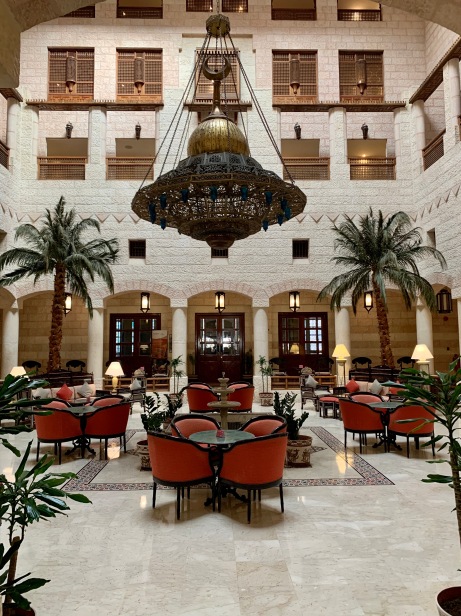
Other best hotels in Petra: Petra Marriott Hotel, Hyatt Zaman Hotel & Resort, Petra Mars Camp, Seven Wonders Bedouin Camp, Little Petra Bedouin Camp
Best Restaurants in Petra
Rainbow Restaurant (Middle Eastern) $
Jordan Heart Restaurant (Middle Eastern) $
Reem Beladi Restaurant (the Mediterranean, Barbecue) $$
Beit Al-Barakah Restaurant (Mediterranean, Middle Eastern) $$
This pleasant coffeeshop with its floral window boxes is right on the roundabout at the center of town and is a pleasant place to sit with a Turkish coffee (JD1). The shawarma sandwiches, one of only a handful of snacks on offer, are generous enough to make a meal of it.
Al Saraya Restaurant (International) $$
Serving a top-notch international buffet in an elegant banquet hall, this fine-dining restaurant offers quality dishes that match the general opulence of the Mövenpick Hotel in which it is located.
Al Qantarah (Mediterranean, Middle Eastern) $$
Wadi Musa’s best restaurant specializes in Jordanian food and serves up to 500 people in one lunch sitting. There is no menu – lunch and dinner are buffet style with 15 kinds of salads and mezze, eight meat and soup dishes and eight kinds of dessert. There’s a cooking station and live music every day in the delightful, traditional dining rooms.
Petra Magic Restaurant (Middle Eastern, Barbecue) $$
A sumptuous buffet of lentil soup, 18 kinds of salad and mezze, eight hot dishes and a pasta station make this restaurant, on the approach into central Wadi Musa, a good-value lunch venue. The views from the panoramic windows lend an added incentive to make the hike out of town.
Sandstone Restaurant (Middle Eastern) $$
This popular restaurant offers a simple fare of tasty mixed grills, salads, and mezze and has an outdoor terrace that is particularly popular at lunchtime. Beer and wine are discreetly served outside or served with greater aplomb for an indoor party over tasty Jordanian dishes.
Little Petra
Little Petra, also known as Siq al-Barid is an archaeological site located north of Petra and the town of Wadi Musa in the Ma’an Governorate of Jordan. Like Petra, it is a Nabataean site, with buildings carved into the walls of the sandstone canyons. As its name suggests, it is much smaller, consisting of three wider open areas connected by a 450-meter (1,480 ft) canyon. It is part of the Petra Archeological Park, though accessed separately, and included in Petra’s inscription as a UNESCO World Heritage Site.
Like Petra, it was probably built during the height of Nabataean influence during the 1st century C.E. While the purpose of some of the buildings is not clear, archaeologists believe that the whole complex was a suburb of Petra, the Nabatean capital, meant to house visiting traders on the Silk Road. After the decline of the Nabataeans, it fell vacant, used only by Bedouin nomads, for centuries. Along with neighboring Beidha, Little Petra was excavated in the late 20th century.
